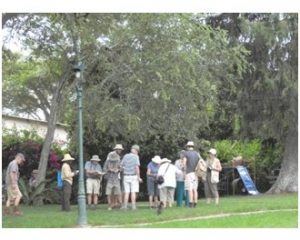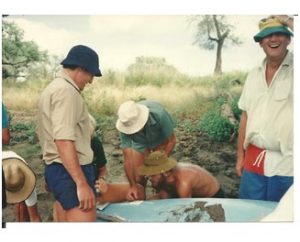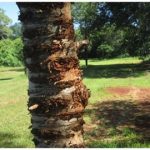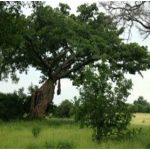TREE LIFE
April 2020
MASHONALAND CALENDAR
Committee Decisions March 2020
We have not been spared from the Covid 19 pandemic and thus have to take whatever measures we feel we need so as not to put our members at risk. Therefore, we have decided, with immediate effect, to cancel all tree outings till further notice. Our web-site will be updated with this notification so it remains up to date.
Without tree outing reports, the one thing that we are concerned about is the lack of material for the forthcoming issues of Tree Life. To this end, we appeal to members to scratch their heads and come up with anything that may provide us with interesting material to continue producing reasonably-sized and informative newsletters. Ann Sinclair will give us something on all the tree-planting she has undertaken over a long period of time – she can also tell us what success she has had many years down the line! I feel there are many other members who have had tree-planting experiences and can also enlighten us on their results.
Has anyone got a memory of some outstanding happening on a Tree Society outing from long ago which was not mentioned in the Tree Life of that month on the web site, I am thinking of folk like Phil, Sheryl, Kim, Mark and Meg, Ann and Jim?
Because of the present financial situation, your committee has decided to delay deciding on the level of subs until April, at which time the treasurer will advise all members. It is our intention to budget for our minimal running expenses and for one fumigation of the herbarium.”
Tree of the month Colophospermum mopane.
Our tree of the month is an iconic species that could help to address malnutrition, boost foreign currency earnings and mitigate the effects of climate change.
It is none other than the Mopane, Colophospermum mopane. We all know it, with its butterfly-shaped leaves that turn yellow in autumn, and its sticky kidney-shaped seeds that are as wrinkled as a human brain.

Lilians lovebirds are endemic to mopane woodlands. Photo lip kee. Wikimedia commons
Mopane forests in the Zambezi Valley and the Lowveld are alluring places: they are home to stunning birds like the Lilian’s Lovebird and Arnot’s Chat.
But at this time of the year they also host the speckled black and yellow larvae of the Mopane moth, Gonimbrasia belina, known locally as Madora or Macimbi.
I spoke to Zimbabwean food scientist Molly Muleya, a researcher at the UK’s University of Nottingham. Molly is part of ‘Future Protein’, a group of researchers investigating more sustainable food sources for humanity.

Mopane worm caterpillar of the mopane moth. Photo: Louis Blythe Wikimedia Commons
As part of her PhD research, Molly investigated how adding natural Zimbabwean food products to traditional porridge, or bota, made it more nutritious. One of those products was the powder from crushed mopane worms.
Molly found that just two or three tea spoons of mopane worm powder added to a serving of millet, sorghum or maize porridge could boost the levels of zinc and iron, key nutrients absent from bota. A 2015 survey found that a third of Zimbabwean children under the age of five suffer from a shortage of zinc, which is necessary for the immune system to function properly.

Mopane tree under a net to protect the caterpillars from birds. Photo Mopane Worms Enterprise
It’s not just nutrition that can be boosted by Mopane worms.
ZimTrade, the main trade promotion body, says it’s looking at Mopane worms as a potential export crop.
But how environmentally-friendly is Mopane worm harvesting?
In some areas the caterpillars are over-harvested. In others, trees are cut down so that inaccessible branches can be reached for short-term gain.
I spoke to Blessing Mutedzi, co-director of Mopane Worms Enterprises, a caterpillar farm in Marange, close to the diamond fields.

Mopane seeds collected and packaged. Photo: Mopane Worms Enterprises
In addition to raising caterpillars for food, the group has grown 5,000 Mopane seedlings on their one-acre plot and taught others in the district about Mopane worm farming. The farm also grows seedlings of the Jackal-berry, Diospyros mespiliformis, another species known to host the caterpillars.
The caterpillars on the farm are collected in sand basins surrounded by plastic that are set up beneath each Mopane tree. When the caterpillars descend from the tree tops to bury themselves in the sand to pupate, they are collected.
Not all are harvested, a number are allowed to turn into moths to perpetuate the species.
If the government is serious about promoting exports, it will need to give farmers support, and promote Mopane worm farming as a serious business, says Blessing.
Mopane worms can fetch up to 14 US dollars per kilogramme, he says.
Finding an alternative economic use for the Mopane tree might be key to ensuring its survival. Mopane forests are being felled throughout their range to fuel the hardwood timber and charcoal trade, especially in Zambia and Mozambique.
This is threatening the creatures that depend on them.
A recent study in Zambia, for instance, showed that Lilian’s Lovebirds are mostly confined to old-growth mopane woodland, where trees exceed 30 centimetres in diameter. These trees have natural cavities that the birds use to nest and roost in.
Yet it’s the big trees that the charcoal-makers target.
Without Mopane trees, there will be far fewer Mopane worms, with all the goodness they bring to the diets of hundreds of thousands of people throughout the region.
Local ventures like Mopane Worms Enterprises may still be ahead of the curve. But climate-friendly farming that incorporates the responsible stewardship of our indigenous woodlands should have our support.
-Ryan Truscott
Botanical Garden walk Saturday 7th March 2020
Nine of us met at the car park at 8:30 and, after admiring the two huge Msasas and noting that they were fruiting, we set off to explore. Tony was our leader and, also present, were Sarah, Jan, Jim & Ann, Jim Dryburgh, Margaret (all the way from Kadoma) and the expert Meg.
A short walk brought us to the Wing Pod, Xeroderris stuhlmannii, which had masses of flat, light green pods on some of the branches and other branches had no pods. We pondered why this may be but did not find a solution.

Grewia lepidopetala fruit buds. Photo: Jim Dryburgh
The next tree we looked at also gave us food for thought. It looked like Grewia stolzii but on closer examination, the flower petals were curled and not straight and also, although some of the fruit had four segments, they were not as well defined as in stolzii and there were some fruits that had two or three segments. Meg took samples and later on identified it as a Grewia lepidopetala. Green-haired Grewia. Later, we identified a different Grewia – flavescens with fluted bark.
We saw several Diospyros species – D. sinensis with its little green fruit, D. kirkii with hard, furry leaves and D. squarrosa which had fluted branches and no hairs but the first one we saw was another unknown. It had obovate, soft hairy leaves. We walked under the beautiful, big, shady Tamarindus indica, past a Kigelia africana and the fascinating Wooden Pear, Schrebera trichoclada to two trees that were a cause of more discussion!

Cordia mukuensis bark Photo by Jim Dryburgh
They were both Cordia mukuensis but the bark looked very different. The bark of the smaller, younger tree was peeling all over while that of the older tree was only peeling in a few places so the bark looked very smooth. Another wonder of nature is the way in which touching branches of these trees fuse together.
We identified the Bird Plum, Berchemia discolor, a Strychnos potatorum and a Feretia aeruginescens. In the same area were several Pawnbroker trees, Excoecaria bussei, and Ziziphus abyssinica. The former had lots of milky sap and attractive fruit that looked like the sign outside a pawnbroker’s shop while the latter had rather vicious thorns but lots of pretty little yellow flower Bauhinia tomentosa had small, soft, hairy pods and larger yellow flowers with a red dot inside which is a guide for insects to find the nectar. The large Erythrina lysistemon produces the tiny lucky beans while the Combretum hereroense has leaves that look like cute little mouse ears and pretty two-toned brown fruit.

Ziziphus abyssinica flowers. Photo : Jim Dryburgh
By now we had reached the Zambezi area and the first tree we looked at was the very attractive Erythroxylum zambesiacum. It was full of small oval fruit coloured green, yellow and red and looked quite Christmassy! The Torchwood, Balanites maughamii, had huge dangerous-looking thorns that branched and unusual bifoliate leaves. The name Balanites means ‘acorn-shaped’ referring to the fruit and Maugham was the name of the British Consul in Maputo who sent samples of the tree to Kew in 1911.
Tony marvelled at the huge size of the Carrot tree, Steganotaenia araliacea, whose crushed leaves smell just like carrots. We admired a tall, beautiful Baobab tree which is obviously thriving in the Harare climate. We ended our walk by looking at a Mnondo tree and noting that, unlike the Msasas in the parking area, it was just coming into flower.
Thank you Tony for an interesting and enjoyable hour and a half.
–Dawn Siemers
It is with great pleasure that we publish this very interesting short article from Ian Riddell, one of our long standing members and one so knowledgeable on such a variety of subjects. We hope to hear more from you Ian. Ed.
Monoceromyia unipunctata and a link to Acacia
Monoceromyia unipunctata is a species of hoverfly or drone fly (Syrphidae) and like all Cerioidini include some of the most perfect mimics of noxious Hymenoptera known. When I first saw this amazing wasp mimic, in Grasmere Lane in Borrowdale back in February 2016, it was quickly apparent that it was a fly – the characteristic halteres gave it away (halteres are a pair of small club-shaped organs on the body behind the pair of wings and provide information about body rotations during flight; they are modified hind wings). It was a male and at the base of an Acacia sieberiana. Well, that’s just where he was and that meant nothing at the time.

Two nyanga flat-tops acacia abyssinica with egg laying drone flies.-
Fast-forward to 26 October 2019 and our Tree Society visit to Karl van Laeren’s veterinary premises off the Borrowdale Road… On our stroll around the grounds I was excited to see another Monoceromyia on an Acacia abyssinica (Vachellia for those accepting Australia’s high-jacking of the genus), but this one was certainly up to something. She (as it turns out: well-separated eyes) was very actively ‘working the bark’ and ovipositing in the cracks. And there was another and then another on an adjacent tree, all busy as bees… or should that be flies?
Once on an Acacia so what; twice, well that got me wondering if this was a coincidence or was there more to the story?

Monoceromyiais Is that an egg on the bark at the base of the ovipositor?
It turns out that exuded tree sap and holes in trees are known breeding sites for some cerioidine larvae and pupae on other continents and the plants include Fraxinus (wet, decaying roots), Ulmus, Populus, but also bamboo and the liquid centre of a cut Agave. The various breeding sites may explain some of the morphological features of cerioidine early stages but I don’t know what a Monoceromyia larva looks like.

Monoceromyia with ovipositor deep in a crack. the halteres can be seen behind the wings. Photo: Ian Riddell
I should think that very little is known about the biology of Monoceromyia unipunctata but from Florida, Monoceromyia floridensis has been photographed egg-laying in tree sap (see Bug guide link) in the same manner as happened here. And whilst we still know next to nothing about unipunctata this adds a little more information and it can be advocated that they breed in Acacia and the larvae and pupae quite possibly utilise the sap or gum.
For those who would like to explore the intricacies of nomenclature and taxonomy related to this fly, see the extensive comment in the iNaturalist observation link below.
https://www.inaturalist.org/observations/2696343
https://bugguide.net/node/view/79818
Ian Riddell
Tree Society outing to Bushman’s Rock Sunday 15th March 2020
Fifteen members of the Tree Society turned up to enjoy the beautiful setting of Bushman’s Rock. Rick Passaportis, our host, welcomed us and invited us to use the Winery as a base. This has a great view of the wooded valley and hills beyond. This was much appreciated as several of our members are no longer very mobile.
Rick them led us round the surrounds of the winery and his garden where most of the trees have been planted. We were also accompanied by Moses, a Safari guide, who was keen to learn the trees and to label the trees as we identified them.
A Schotia brachypetala, and Acacia xanthophloea, a mystery exotic, an Acacia abyssinica and an Erythrina lysistemon were outside the gate to the house. Just inside two handsome Ficus microcarpa on each side of the path and an exotic fig from China.

Serious discussions going on. photo from Jim Dryburgh
Lower down two magnificent Acacia sieberiana dominated the garden. The lawn slopes down to a Callistemon, Bottle brush from Australia, when in flower attracts myriads of sunbirds and bees.
There is a very tall Palm, Washingtonia robusta, the Mexican fan palm from New Mexico and Baja California. Known as the sky duster and is a refuge for Palm Swifts.
A Kigelia africana, Sausage tree with very hard leathery leaves, a Loquat laden with fruit and an old Cherry tree were close to the fence.
Along the road leading to the house were an Olea europaea, the wild Olive, a Mystroxylon aethiopicum, Kooboo berry which grows in a wide variety of vegetation types often on termite mounds.
A small Acacia with very long white straight thorns was growing by the side of the road and a Dichrostachys cinerea, Sickle bush, with flowers in a pendulous spike, the lower part with pink sterile flowers and the upper part with yellow fertile flowers. The pods are curly and twisted.
Cordia africana, Large leaved saucer berry has showy white flowers which are pollinated at night, they are short lived and fall to form a magical white carpet under the tree.
Grewia stolzii, a small gnarled tree, a Pittosporum viridiflorum, Cheesewood the fruit is a capsule, which is dehiscent the seeds are sticky and a bright orange red in colour.
Searsia tenuinervis leaves have three sessile leaflets rounded and toothed towards the apex.
Also lining the road is a Eucalyptus cinerea, the Silver Dollar, with grey rounded leaves and then we saw Pterocarpus rotundifolius, Blood wood which has very showy yellow flowers in long panicles. It flowers for a few days after the rain has fallen.
Afzelia quanzensis. Pod mahogany, has beautiful large flat pods with large black seeds with a red aril. Acacia polyacantha, the white stemmed Acacia with hooked paired thorns and yellow/white flowers in spikes.
A succulent bed by the fence had a large Mexican cactus in flower, a Euphorbia tirucalli, Aloe arborescens, other Aloes and species of echeveria. Acacia galpinii the monkey thorn, flowers with showy long white spikes before the leaves come out.
We turned up a path into natural bush and found a Bridelia sp. Uapaca kirkiana the Mahobohobo with large leaves and inconspicuous greenish yellow flowers. The fruit is edible and sweet tasting often fermented to make an alcoholic wine. Catunaregam taylorii found in bushveld and miombo woodland. Monotes glaber, yellow helicopter, the pods dry and have 5 persistent sepals.
Burkea africana distinguished by velvety reddish brown hairs, a red dye is made from the roots and the bark is powdered and used as a fish poison.
Psorospermum febrifugum. Christmas berry a shrub or small tree with creamy white flowers, and the fruit a small berry bright red to dark red which is evident between November and March.
Vangueria infausta, the Wild-medlar, Ochna schweinfurthiana bark is dark grey and thick cracked into a grid like pattern and fruit in shiny black drupes in a receptacle surrounded by brick red petal like sepals.
Vangueriopsis lanciflora the false medlar, is similar to Vangueria infausta which has pale green leaves more or less the same colour and is densely hairy on both sides. Vangueriopsis lanciflora is one of the trees known as ‘live long’ as posts put in the ground usually grow.
Swartzia madagascariensis a small semi-deciduous tree with a gnarled trunk, flowers with a single crinkled petal. Pods are cylindrical up to 300 mm long, dark brown and eaten by cattle.
Flacourtia indica a small tree with red autumn colours. Finally the Duiker berry, Pseudolachnostylis maprouneifolia with dark red to yellow autumn colours. Leaves and fruit are eaten by antelope and elephant.
Thank you to Rick for hosting our excellent day at Bushman’s Rock. We were sad we could not take up your offer of a walk by the river. This will be good for another visit in the future which we look forward to.
-Ann Sinclair
And in this period of Lockdown and Covid-19 tensions, we need a little light relief and I intending producing, over the next three months, the intriguing account of Jim and Ann Sinclair’s canoe trip down the Zambezi. These are reproduced from our Website and originally appeared in April, May and June 1990, Tree Life Nos. 122, 123, 124 on the Website. Those of us who have had wonderful experiences on the Zambezi will reminisce and the rest will be dreaming about a similar trip when we are released from Lockdown. Ed
A CANOE TRIP – OR WILL THEY STILL BE TALKING TO EACH OTHER WHEN THEY GET BACK???
The whole idea seems a bit preposterous when you think about it. 6 middle aged couples on a canoe trip down the Zambezi River roughing it at night sleeping on the ground underneath the stars facing hippos, crocs, swirls and eddies and Heaven knows what else for three nights and two and a half days.
When did it all start and why?
It all seems to have begun sitting round drinks one evening at the Cutty Sark in Kariba at the Cattle Producers Association annual congress in 1988. At the time I do not think anyone thought seriously that it was anything other than idle chatter except Ben and Jenny Norton who have a way of making things happen.
And so they begin organising the trip and persuading all the busy farmers cum company directors cum board chairmen to keep a week free in their diaries so we could embark on this ambitious escapade. We were sent brochures and given the dates and so it all started to happen. The brochures made the whole thing look remarkably attractive but there was one feature they all had in common. Not one of the pictures showed anyone who could possibly be over the age of 25. that did not deter us however and so eventually we arrived at Chirundu on Monday 3rd April for our individually tailored canoe safari. The original idea had been a leisurely trip to Rukomechi from Chirundu taking two and a half days but National Parks have specified sleeping areas and there were not enough of those between these two points to allow such a plan so at the last minute we were told that we would be going to Mana another day beyond Rukomechi, giving a total canoeing distance of about 70km and then brought back to Rukomechi by boat where we were to spend two days in the luxury of the Rukomechi Safari Camp.
The members of the party were Ben and Jenny Norton, Dave and Margy Tredgold, Bob and Vicky Rutherford, Mick and Cathy Townsend, Charlotte and Keith Kirkman and Jim and Ann Sinclair. Ages ranged from 43 to 60.

This was the motley crew that found themselves on the banks of the Zambezi underneath the Chirundu Bridge at midday looking with some apprehension at the 8 two man canoes lines up on the bank. Each canoe was 5.7 metres long made of fibreglass with a seat at the front and back and in the middle was a box containing the food and hardware such as folding tables, stools and so on. We packed our kit in around this and once again felt smug about our success in travelling light, a result of many years experience and not the case with all the party!!
We met our guides Titch Atkinson and Anthony Elton. Titch is not a full time guide being the manager of Rukomechi Camp but was filling in because there was a shortage of full time guides. They have to pass several exams before they are allowed to take parties on the river. We were divided into two parties and we had Titch as our guide and most satisfactory was his knowledge was first class and he was happy to impart it and Ann was able to spend much time on her tree interest with him. Although some members of the party felt they did not want to travel with their spouses we were happy to do so and were glad that was the way it turned out.

Hole in the boat. Larry Norton supervising- Tich Atkinson repairing. Photo from Jim Sinclair
The first impression of course was the sheer size of the river and the volume flowing down it. The Zambezi is of course the heart of one of the world’s great river systems and we were familiar with it from our previous trips with Ben and Jenny in Ben’s speed boat. But this was very different and here we were in these insignificant canoes paddling along learning how to steer and keep up with the guide and marvelling at it all. The trick is to remember that 70% of the steering effect is in the hands of the rear paddler so to speak and we soon learnt that it is not a matter of merely drifting but that you really do have to work quite hard. The front man is also important from an effort point of view and the whole effect seems designed to test a partnership to the hilt. I have to say that Ann and I got on just fine and exchanged no harsh words and soon got the hang of it all.
I had been very worried that the effort of paddling might be very hard on the shoulders but I need not have worried and we soon set into a rhythm which gave us time and the opportunity to start observing the scene around about us. You certainly get a different perspective on life when you are seated a couple of inches from the surface of a mighty river such as the Zambezi.
We paddled out into the river and past the ruins of the Chirundu Sugar Estate and through flat and rather featureless terrain before getting into more wooded and interesting country a little further downstream.
To be continued Jim and Ann Sinclair
TONY ALEGRIA CHAIRMAN



